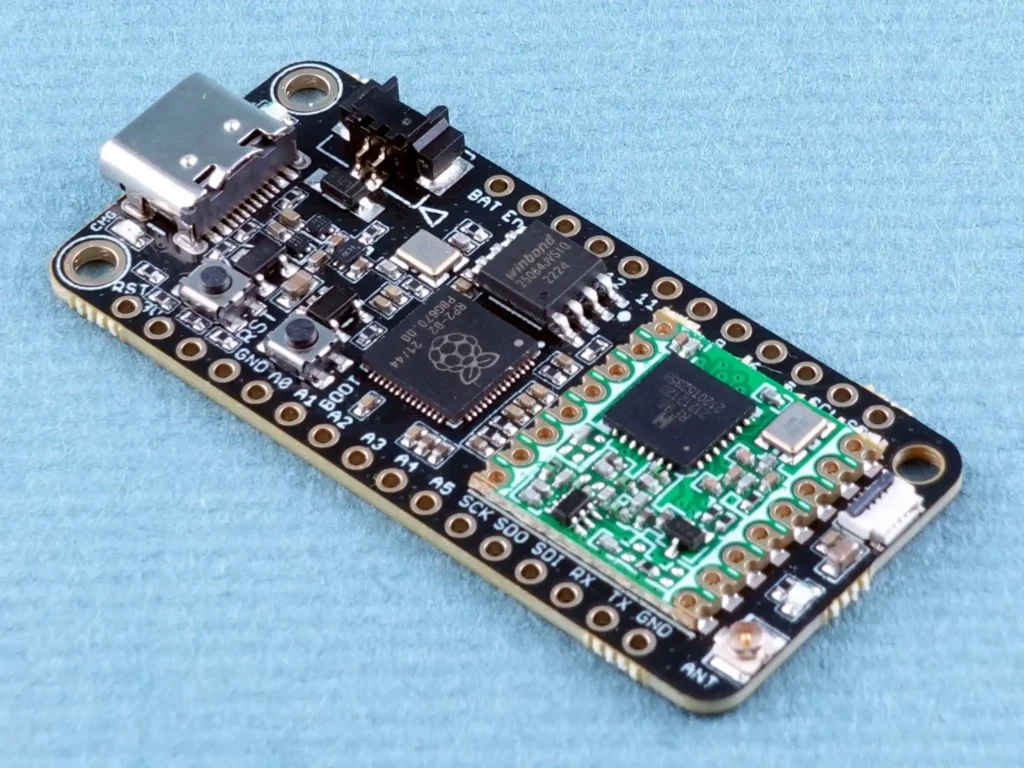iLabs Electronics Challenger+ RP2040 LoRa Mk II is a small development board based on the dual-core 133 MHz RP2040 microcontroller and including an onboard RFM95W LoRa transceiver. It has the Feather form factor (50.8 x 22.86 mm) which allows it to be used in a breadboard, a 1.25 mm JST li-po battery input connector, and USB-C power and program connection.
The Mk II revision introduces an upgraded power architecture that separates the MCU and RF power domains to minimize noise and enhance signal stability. It also adds a new “BConnect” expansion interface supporting UART and I²C peripherals. With these improvements, the Challenger+ RP2040 LoRa Mk II offers a reliable platform for low-power IoT nodes and long-range wireless sensor network applications.
Previously, we covered the Shrike Development Board, which combines the Raspberry Pi RP2040 microcontroller with a Renesas ForgeFPGA. Feel free to check it out if you’re interested.
Challenger+ RP2040 LoRa MkII Specifications:
It is an embedded board based on the Raspberry Pi RP2040 microcontroller, with a 133 MHz, two-core Arm Cortex-M0+ processor with 264 KB of SRAM and 8 MB of flash storage. The combination is sufficient in processing capabilities and storage to support sensor data capture, wireless communication and embedded general operations. The board uses Feather-standard form factor, 50.8 x 22.86 mm, and has a USB-C programming, data transfer, and power input connector as well as a JST 1.25 mm single-cell Li-Po battery connector.
In the case of wireless connectivity, it has an RFM95W LoRa module of Semtech based, which uses 868 MHz or 915 MHz, according to the regional setup. The transceiver has a maximum transmit power of +20 dBm and a minimum receive sensitivity of -148 dB which has a link budget of approximately 168 dB which is adequate to support long-range communication in IoT and remote monitoring systems. The antenna is connected with the help of U.FL (IPEX), and the SPI interface is used to connect the LoRa module with the RP2040 in order to transmit data swiftly and dependably.
RFM95W Simplified Block Diagram
The Mk II model introduces an improved power management design with isolated power domains for the MCU and RF sections, reducing noise and enhancing performance in sensitive wireless applications. It also features iLabs’ proprietary BConnect expansion interface, which exposes UART and I²C lines for easy peripheral integration. Additional I/O options include GPIO, SPI, I²C, UART, PWM, and four analog inputs, making the board highly versatile for embedded and IoT prototyping.
Challenger+ RP2040 LoRa MkII Pinout
The board can be used to develop the Arduino ecosystem with the RP2040 core by Earle Philhower and in CircuitPython with the official distribution by Adafruit. Applications can be constructed on LoRa with ease and the RFM95W transceiver can be interfaced using the included I/O pins and talked to over SPI. It has a built-in power management that automatically selects the USB power source and Li-Po battery to provide it with power, which reduces its design complexity and avoids the use of extra power circuitry in most projects.
You can purchase the Challenger+ RP2040 LoRa Mk II directly from the iLabs website for $29.48. For detailed technical information and specifications, refer to the product’s datasheet page.



